Artículos
Publicado 2024-12-17
Palavras-chave
- term logic,
- numerical logic,
- fuzzy logic
Direitos de Autor (c) 2024 Tópicos, Revista de Filosofía

Este trabalho encontra-se publicado com a Licença Internacional Creative Commons Atribuição-NãoComercial-SemDerivações 4.0.
Como Citar
Castro-Manzano, J.-M. (2024). ¿Es la lógica de Szabolcsi una lógica difusa?. Tópicos, Revista De Filosofía, 71, 345-362. https://doi.org/10.21555/top.v710.2825
Resumo
In this paper we ask ourselves whether Szabolcsi’s numerical term logic is a fuzzy logic. Our answer is in the affirmative. In order to justify such a claim, we first expound some preliminaries that help us understand why the inclusion of fuzzy quantifiers is a sufficient condition for fuzziness. Then we present Szabolcsi’s logic, which includes said quantifiers.
Referências
- Castro-Manzano, J.-M. (2019). An Intermediate Term Functor Logic. Argumentos. Revista de Filosofia, 22, 17-31. DOI: https://doi.org/10.36517/Argumentos.22.2.
- Castro-Manzano, J.-M. (2021). Traditional Logic and Computational Thinking. Philosophies, 6, 12. DOI: https://doi.org/10.3390/philosophies6010012.
- Castro-Manzano, J.-M. (2022). On Mixing Term Logics. In B. Liao, R. Markovich, & Y. N. Wáng (eds.), Logics for New-Generation AI. Second International Workshop. 10-12 June 2021, Zhuhai. (pp. 6-23). College Publications. URL: https://www.collegepublications.co.uk/LNGAI/?00002.
- Correia, M. (2017). La lógica aristotélica y sus perspectivas. Pensamiento, 73(275), 5-19.
- Englebretsen, G. (1996). Something to Reckon with: The Logic of Terms. University of Ottawa Press.
- Dubois, D., Godo, L., de Màntaras, R. L., & Prade, H. (1993). Qualitative Reasoning with Imprecise Probabilities. Journal of Intelligent Information Systems, 2, 319-363. DOI: https://doi.org/10.1007/BF00961659.
- Dubois, D. & Prade, H. (1988). On Fuzzy Syllogisms. Computational Intelligence, 4(2), 171-179.
- Murphree, W. A. (1998). Numerical Term Logic. Notre Dame Journal of Formal Logic, 39, 346-362.
- Pereira-Fariña, M., Vidal, J. C., Díaz-Hermida, F., & Bugarín, A. (2014). A Fuzzy Syllogistic Reasoning Schema for Generalized Quantifiers. Fuzzy Sets and Systems, 234, 79-96.
- Peterson, P. L. (1979). On the Logic of “Few”, “Many”, and “Most”. Notre Dame Journal of Formal Logic, 20, 155-179.
- Simons, P. (2020). Term Logic. Axioms, 9(1), 18. DOI: https://doi.org/10.3390/axioms9010018.
- Sommers, F. (1982). The Logic of Natural Language. Oxford University Press.
- Szabolcsi, L. & Englebretsen, G. (2008). Numerical Term Logic. Edwin Mellen Press.
- Thompson, B. (1982). Syllogisms Using “Few”, “Many”, and “Most.” Notre Dame Journal of Formal Logic, 23, pp. 75-84.
- Thompson, B. (1986). Syllogisms with Statistical Quantifiers.” Notre Dame Journal of Formal Logic, 27, 93-103.
- Wang, P. (1997). Return to Term Logic. In P. Flach and A. Kakas (eds.), Proceedings of the IJCAI’97 Workshop on Abduction and Induction in AI. (pp. 1-9). International Joint Conferences on Artificial Intelligence Organization. URL: https://www.researchgate.net/publication/2257541_Return_to_Term_Logic.
- Zadeh, L. A. (1985). Syllogistic Reasoning in Fuzzy Logic and its Application to Usuality and Reasoning with Dispositions. IEEE Transactions on Systems, Man, and Cybernetics, 15(6), 754-763. DOI: https://doi.org/10.1109/TSMC.1985.6313459.





